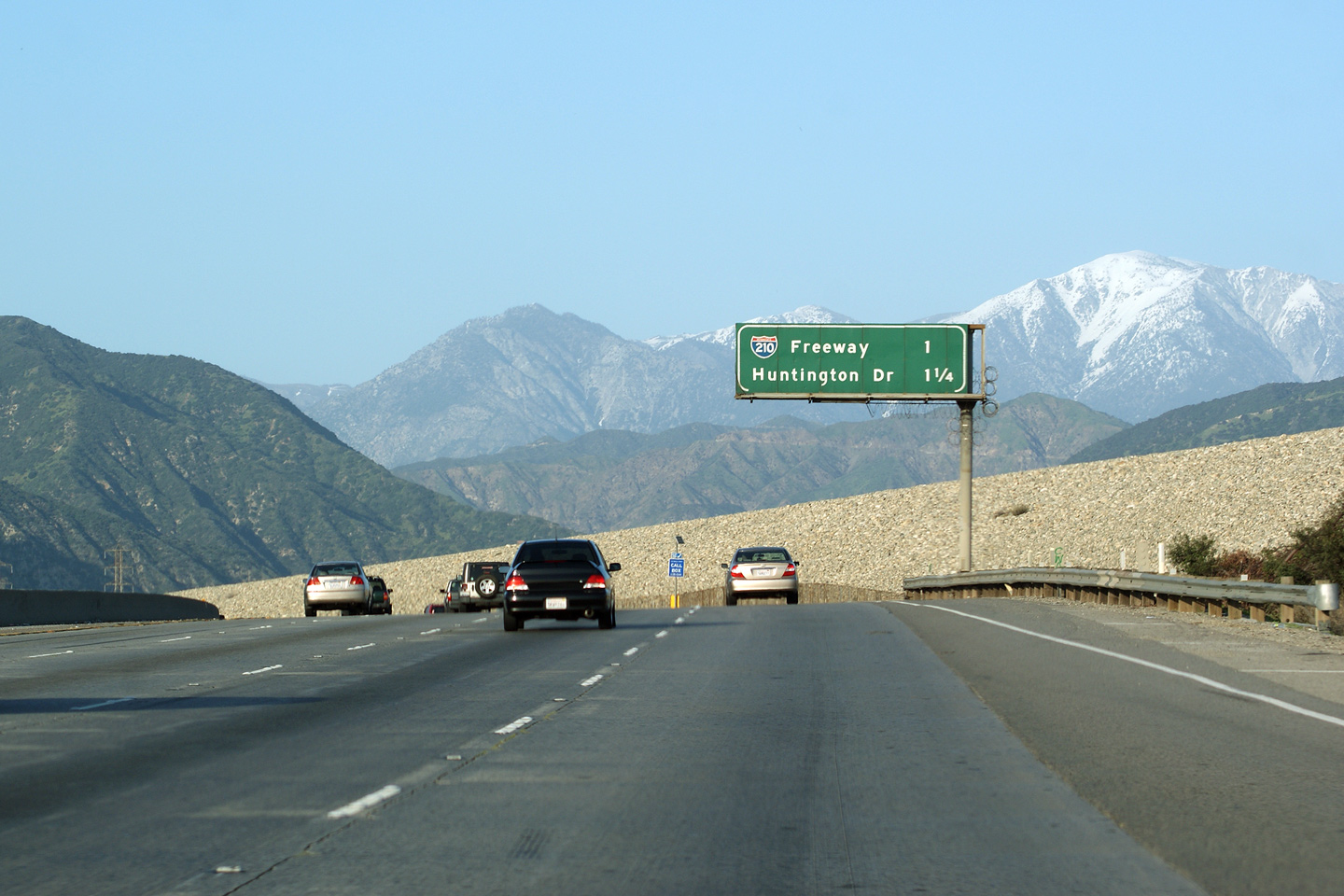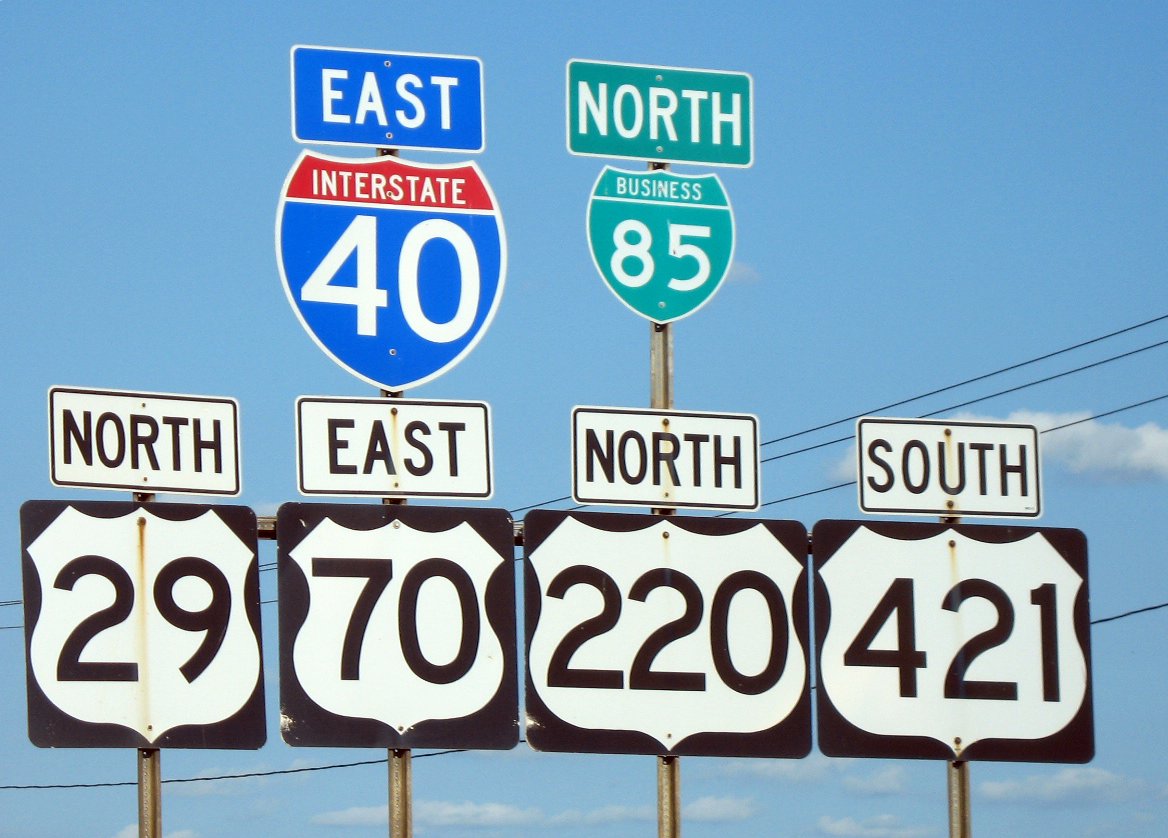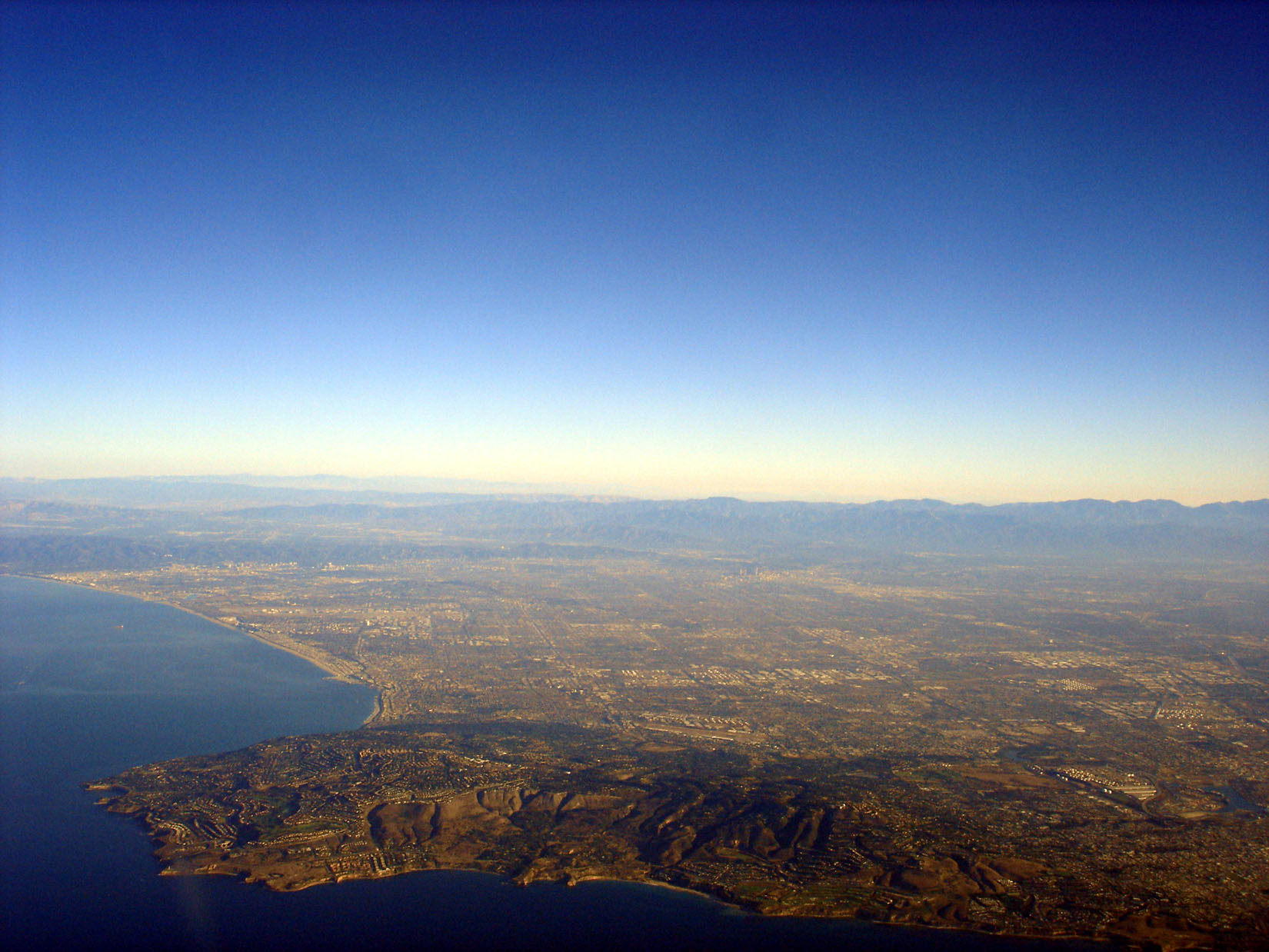|
California State Route 60
State Route 60 (SR 60) is an east–west state highway in the U.S. state of California. It serves the cities and communities on the eastern side of the Los Angeles metropolitan area and runs along the south side of the San Gabriel Valley. It functions as a bypass route of Interstate 10 (I-10) through the area between the East Los Angeles Interchange in Los Angeles and Beaumont. SR 60 provides a route across several spurs of the Peninsular Ranges, linking the Los Angeles Basin with the Pomona Valley and San Gabriel Valley. The highway also runs concurrently with SR 57 and I-215. Portions of SR 60 are designated as either the Pomona Freeway or the Moreno Valley Freeway. Route description SR 60 begins at the East Los Angeles Interchange near Downtown Los Angeles, designated as the Pomona Freeway. The freeway heads east from the junction after splitting off from I-10 (Santa Monica Freeway) and passes through East Los Angeles, intersecting I-710 (Long ... [...More Info...] [...Related Items...] OR: [Wikipedia] [Google] [Baidu] |
California Department Of Transportation
The California Department of Transportation (Caltrans) is an executive department of the U.S. state of California. The department is part of the cabinet-level California State Transportation Agency (CalSTA). Caltrans is headquartered in Sacramento. Caltrans manages the state's highway system, which includes the California Freeway and Expressway System, supports public transportation systems throughout the state and provides funding and oversight for three state-supported Amtrak intercity rail routes (''Capitol Corridor'', ''Pacific Surfliner'' and ''San Joaquins'') which are collectively branded as ''Amtrak California''. In 2015, Caltrans released a new mission statement: "Provide a safe, sustainable, integrated and efficient transportation system to enhance California’s economy and livability." History The earliest predecessor of Caltrans was the Bureau of Highways, which was created by the California Legislature and signed into law by Governor James Budd in 1895.Raymon ... [...More Info...] [...Related Items...] OR: [Wikipedia] [Google] [Baidu] |
San Gabriel Valley
The San Gabriel Valley ( es, Valle de San Gabriel) is one of the principal valleys of Southern California, lying immediately to the east of the eastern city limits of the city of Los Angeles, and occupying the vast majority of the eastern part of Los Angeles County, California. Surrounding features include: * San Gabriel Mountains on the north, * San Rafael Hills to the west, with Los Angeles Basin beyond, * Crescenta Valley to the northwest, * Puente Hills to the south, with the coastal plain of Orange County, California, Orange County beyond, * Chino Hills and San Jose Hills to the east, with the Pomona Valley and Inland Empire (CA), Inland Empire beyond. * The city limits of Los Angeles bordering its western edge. The San Gabriel valley derives its name from the San Gabriel River (California), San Gabriel River that flows southward through the center of the valley, which itself was named for the Spanish Mission San Gabriel Arcángel originally built in the Whittier Narrows i ... [...More Info...] [...Related Items...] OR: [Wikipedia] [Google] [Baidu] |
Interstate 605
Interstate 605 (abbreviated I-605, officially known as the San Gabriel River Freeway) is a major north–south auxiliary Interstate Highway in the Greater Los Angeles urban area of Southern California. It runs from I-405 and State Route 22 (SR 22) in Seal Beach to I-210 in Duarte. The San Gabriel River Freeway closely parallels the San Gabriel River for most of its alignment, hence its name, which is one of the few Southern California freeways not named after a city along its route. Aside from changes to the interchange with I-105 (which did not open until the early 1990s), and the addition of an HOV lane between I-405 and I-10, I-605 is one of the only remaining freeways that kept its original alignment throughout its run through Los Angeles County since it first opened. Route description The California Streets and Highways Code defines Route 605 as "(a) Route 1 near Seal Beach to Route 405. (b) Route 405 to Route 210 near Duarte." However, the portion in su ... [...More Info...] [...Related Items...] OR: [Wikipedia] [Google] [Baidu] |
Interstate 710
Route 710, consisting of the non-contiguous segments of State Route 710 (SR 710) and Interstate 710 (I-710), is a major north–south state highway and auxiliary Interstate Highway in the Los Angeles metropolitan area of the U.S. state of California. Also called the Los Angeles River Freeway prior to November 18, 1954, the highway was initially planned to connect Long Beach and Pasadena, but a gap in the route exists from Alhambra to Pasadena through South Pasadena due to community opposition to its construction. The completed southern segment is signed as I-710 and is officially known as the Long Beach Freeway, and it runs north from Long Beach to Valley Boulevard, just north of I-10 (San Bernardino Freeway), near the boundary between the cities of Alhambra and Los Angeles. South of I-5, I-710 follows the course of the Los Angeles River, rarely wandering more than a few hundred feet from the riverbed. South of SR 1 in Long Beach, I-710 is offic ... [...More Info...] [...Related Items...] OR: [Wikipedia] [Google] [Baidu] |
Downtown Los Angeles
Downtown Los Angeles (DTLA) contains the central business district of Los Angeles. In addition, it contains a diverse residential area of some 85,000 people, and covers . A 2013 study found that the district is home to over 500,000 jobs. It is also part of Central Los Angeles. Downtown Los Angeles is divided into neighborhoods and districts, some overlapping. Most districts are named for the activities concentrated there now or historically, e.g. the Arts, Civic Center, Fashion, Banking, Theater, Toy, and Jewelry districts. It is the hub for the city's urban rail transit system plus the Pacific Surfliner and Metrolink commuter rail system for Southern California. Banks, department stores, and movie palaces at one time drew residents and visitors of all socioeconomic classes downtown, but the area declined economically especially after the 1950s. It remained an important center—in the Civic Center, of government business; on Bunker Hill, of banking, and along Broadway, of ... [...More Info...] [...Related Items...] OR: [Wikipedia] [Google] [Baidu] |
Phillips Ranch Photo
Phillips may refer to: Businesses Energy * Chevron Phillips Chemical, American petrochemical firm jointly owned by Chevron Corporation and Phillips 66. * ConocoPhillips, American energy company * Phillips 66, American energy company * Phillips Petroleum Company, American oil company Service * Phillips (auctioneers), auction house * Phillips Distilling Company, Minnesota distillery * Phillips Foods, Inc. and Seafood Restaurants, seafood chain in the mid-Atlantic states * Phillips International Records, a record label founded by Sam Phillips Vehicle * Phillips (constructor), American constructor of racing cars * Phillips Cycles, British manufacturer of bicycles and mopeds People Surname * Philip Phillips (other) *Phillips (surname) Given name * Phillips Barry (1880–1937), American academic * Phillips Brooks (1835–1893), American clergyman and author * Phillips Callbeck (1744–1790), merchant and political figure in St. John's Island, Canada * Phillips C ... [...More Info...] [...Related Items...] OR: [Wikipedia] [Google] [Baidu] |
Interstate 215 (California)
Interstate 215 (I-215) is a north–south auxiliary Interstate Highway in the Inland Empire region of the San Bernardino–Riverside urban area in Southern California. It has portions designated as the Barstow, Escondido, and Armed Forces Freeways. I-215 is a bypass auxiliary route of I-15, running from Murrieta to northern San Bernardino. While I-215 connects the city centers of both Riverside and San Bernardino, its parent I-15 runs to the west through Corona and Ontario. Part of I-215 was once signed as Interstate 15E (I-15E), but this was changed in 1974 as almost all of the Interstates around the country with directional suffixes were eventually renumbered or eliminated. Route description The southern terminus of I-215 is at the junction of I-15 in the city of Murrieta, in southwestern Riverside County. It then runs north through Menifee and northwest through Perris, passing March Air Reserve Base before joining State Route 60 (SR 60) in Riverside ... [...More Info...] [...Related Items...] OR: [Wikipedia] [Google] [Baidu] |
California State Route 57
State Route 57 (SR 57), also known as the Orange Freeway for most of its length, is a north–south state highway in the Greater Los Angeles Area of the U.S. state of California. It connects the interchange of Interstate 5 (I-5) and SR 22 near downtown Orange, locally known as the Orange Crush, to the Glendora Curve interchange with I-210 and SR 210 in Glendora. The highway provides a route across several spurs of the Peninsular Ranges, linking the Los Angeles Basin with the Pomona Valley and San Gabriel Valley. A predecessor to this road ran through Brea Canyon by the early 20th century and was added to the state highway system. The freeway was built in stages during the 1950s, one of which included the Brea Canyon Freeway; SR 57 was designated as part of the 1964 state highway renumbering. The final portion of the present-day Orange Freeway was not completed until the mid 1970s. The latest piece of SR 57 to be added was formerly part of I-210, after SR ... [...More Info...] [...Related Items...] OR: [Wikipedia] [Google] [Baidu] |
Concurrency (road)
A concurrency in a road network is an instance of one physical roadway bearing two or more different route numbers. When two roadways share the same right-of-way, it is sometimes called a common section or commons. Other terminology for a concurrency includes overlap, coincidence, duplex (two concurrent routes), triplex (three concurrent routes), multiplex (any number of concurrent routes), dual routing or triple routing. Concurrent numbering can become very common in jurisdictions that allow it. Where multiple routes must pass between a single mountain crossing or over a bridge, or through a major city, it is often economically and practically advantageous for them all to be accommodated on a single physical roadway. In some jurisdictions, however, concurrent numbering is avoided by posting only one route number on highway signs; these routes disappear at the start of the concurrency and reappear when it ends. However, any route that becomes unsigned in the middle of the concurren ... [...More Info...] [...Related Items...] OR: [Wikipedia] [Google] [Baidu] |
Pomona Valley
The Pomona Valley is located in the Greater Los Angeles Area between the San Gabriel Valley and San Bernardino Valley in Southern California. The valley is approximately east of downtown Los Angeles. History On March 1, 1893 the California Assembly voted 54–14 for a new county to form in the region, to be named San Antonio County, with Pomona as its seat. Los Angeles interests in the Senate rejected the concept, however, and today the eastern and western portions of the valley remain divided between San Bernardino and Los Angeles counties (San Antonio Creek). Geography The alluvial valley is formed by the Santa Ana River and its tributaries. The Pomona Valley is separated from San Gabriel Valley to the west by the northeastern end of the San Jose Hills, running approximately along State Route 57. The eastern boundaries are the Jurupa Hills and the Cajon Pass, (the eastern end of the San Gabriel Mountains) running near Interstate 15, which separates the Pomona Valley fro ... [...More Info...] [...Related Items...] OR: [Wikipedia] [Google] [Baidu] |
Los Angeles Basin
The Los Angeles Basin is a sedimentary basin located in Southern California, in a region known as the Peninsular Ranges. The basin is also connected to an anomalous group of east-west trending chains of mountains collectively known as the Transverse Ranges. The present basin is a coastal lowland area, whose floor is marked by elongate low ridges and groups of hills that is located on the edge of the Pacific Plate. The Los Angeles Basin, along with the Santa Barbara Channel, the Ventura Basin, the San Fernando Valley, and the San Gabriel Basin, lies within the greater southern California region. On the north, northeast, and east, the lowland basin is bound by the Santa Monica Mountains and Puente, Elysian, and Repetto hills. To the southeast, the basin is bordered by the Santa Ana Mountains and the San Joaquin Hills. The western boundary of the basin is marked by the Continental Borderland and is part of the onshore portion. The California borderland is characterized by n ... [...More Info...] [...Related Items...] OR: [Wikipedia] [Google] [Baidu] |
Peninsular Ranges
The Peninsular Ranges (also called the Lower California province) are a group of mountain ranges that stretch from Southern California to the southern tip of the Baja California peninsula; they are part of the North American Coast Ranges, which run along the Pacific Coast from Alaska to Mexico. Elevations range from . Geography The Peninsular Ranges include the Santa Ana Mountains, Temescal and other mountains and ranges of the Perris Block, San Jacinto and Laguna ranges of southern California continuing from north to south with the Sierra de Juárez, Sierra de San Pedro Mártir, Sierra de San Borja, Sierra de San Francisco, Sierra de la Giganta, and Sierra de la Laguna in Baja California. Palomar Mountain, home to Palomar Observatory, is in the Peninsular Ranges in San Diego County, as are Viejas Mountain and the San Ysidro Mountains. The Peninsular ranges run predominantly north-south, unlike the Transverse Ranges to their north, which mostly run east-west. Geology Rock ... [...More Info...] [...Related Items...] OR: [Wikipedia] [Google] [Baidu] |








